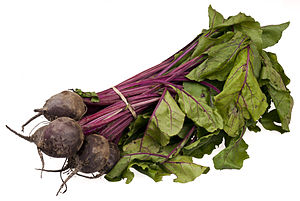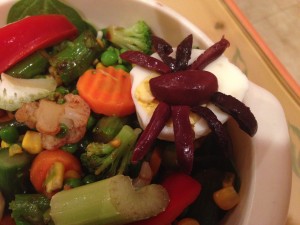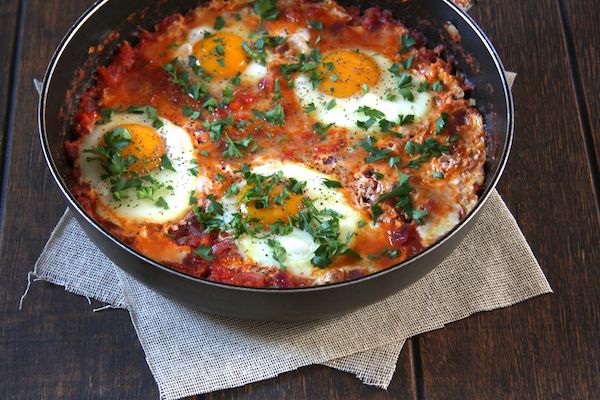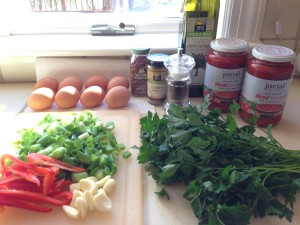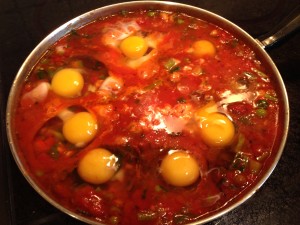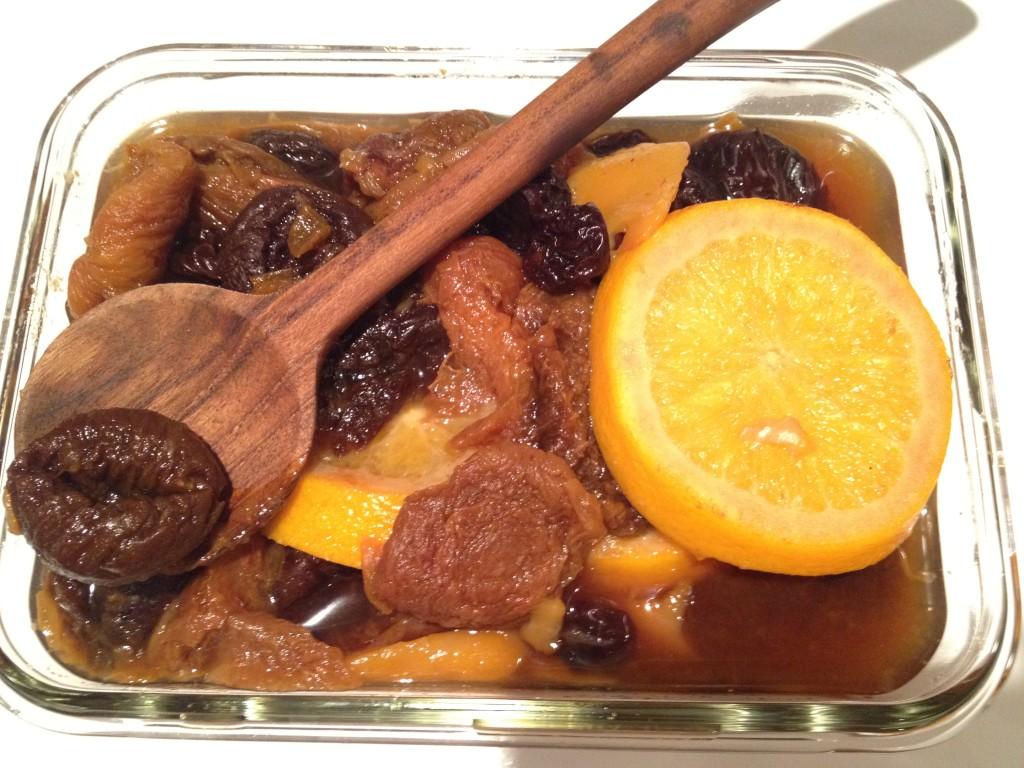Powerful nutrient compounds in beets help to reduce the risk of heart disease, birth defects, and some cancers.
The beetroot in North America is a colorful root vegetable that includes several cultivated varieties of beet (Beta vulgaris) grown for their edible taproots and greens, food coloring, and as a medicinal plant. The usually deep purple roots of beetroot can be eaten boiled, grilled, or roasted, cold as a salad after being cooked and dressed with oil and vinegar, or raw and shredded, either alone or combined with salad vegetables. Beet leaves are edible, nutritious, and can be prepared the same way as Swiss chard.
History of beets (beetroot):
- The wild beet, the ancestor of today’s common beet, is thought to have originated during prehistoric times in North Africa and grown wild along Mediterranean, Asian and European seashores.
- The beet sugar industry traces its origins to ancient Babylon, Egypt, and Greece, where sugar beets were first cultivated. The tap root was not known until the 2nd or 3rd Century AD. The plant was grown from 2000 BC for its leaves and used by Greeks and Romans as ‘Chard’ or ‘Spinach.’ In these early times, people ate just the beet greens, not the roots.
- The ancient Romans were one of the first civilizations to cultivate beets to use their roots as food. Tribes that invaded Rome were responsible for spreading beets throughout northern Europe, where they were initially used for animal fodder and later for human consumption, becoming more popular in the 16th century.
- In the mid-1700’s, the German chemist Andreas Margraff discovered that both white and red beetroot contained sucrose, indistinguishable from that produced from sugar cane.
- Although beet leaves have been eaten since before written history, the root was generally used medicinally and did not become a popular food until French chefs recognized it’s potential in the 1800’s. While the root was eaten in France and Italy as a vegetable, roasted whole, in England it was used as cattle fodder during the 18th Century.
- During the Napoleonic Wars, France was deprived of sugar by the English Fleet and Napoleon encouraged research in the use of sugar beet.
- Beets became more popular in the 19th century, when it was discovered that they were a concentrated source of sugar. In 1801, the first sugar beet factory was built at Cunern in Silesia, Poland. When access to sugar cane was restricted by the British, Napoleon decreed that beets be used as the primary source of sugar. Around this time, beets were also first brought to the United States, where they now flourish.
- The first successful commercial factory to extract sugar from beets in the USA was constructed by E. H. Dyer at Alvarado (now known as Union City), California in 1879.
- Today the leading commercial producers of beets include the United States, Russian Federation, France, Poland, France and Germany.
- Approximately 2/3 of commercial beet crops end up canned.
(Section through taproot)
The “beetroot” is the taproot portion of a beet plant. In North America the beetroot is also called a table beet, garden beet, red or golden beet, or beet.
Botanical name: Beets are botanically known as Beta vulgaris (derived from the Greek letter beta, because the swollen, turnip-like root resembles a Greek B).
Common names for beets:
- Garden beet, beetroot, chard, Swiss chard, sugar beet, blood turnip, spinach beet, biet, juurikas, betteraves, rübe, biatais, barbabietola, beterraba, remolacha, betor.
- Commonly known as the beet in the United States. Outside the United States, beets are usually referred to as beetroot in English-speaking countries.
Beet varieties:
- The most common garden beet is deep ruby-red in color.
- Yellow, white, and candy-striped (with red and white concentric circles) beets are available in specialty markets.
- Betanin, obtained from the roots, is used industrially as red food colorant to improve the color and flavor of tomato paste, sauces, desserts, jams and jellies, ice cream, sweets, breakfast cereals, etc.
- Sugar beets are used to make table sugar.
- Beetroot dye is sometimes used in ink.
When are fresh beets in season?
- In North America, fresh beets are available from June through October (mid-summer through early fall). Some markets import fresh beets from opposing climates and sell them year-round. Beets are also readily available canned.
- Costco now sells USDA organic, cooked beets in 1-pound plastic containers.
When buying fresh beets:
- To insure freshness, select beets with leaf stems still attached and small leaves that are not yellow or tattered. The greens reflect how fresh the beets are: if they look moist and fresh, the beets will be too. Avoid beets that appear dry, cracked, shriveled, or have scales or spots.
- Choose small, firm beets with deep maroon coloring, unblemished skin, and bright green leaves that are not wilted. The taproot should still be attached.
- Avoid large beets with a hairy taproot. The tiny roots (hair) are an indication of age and toughness.
- Most beets that come to market will be 1-1/2 to 2 inches in diameter. Larger beets tend to have a tough, woody center. Smaller beets will be sweeter and more tender.
- The leaves are edible and nutritious and can be prepared the same way as Swiss chard (also known as spinach beet).
- Try to purchase fresh, organic beets whenever possible (95% of sugar beets in the United States are genetically modified).
- Fresh beets are generally inexpensive, but must be washed and boiled. As an alternative, you can use packaged ones in plastic bags which are already cooked and peeled. They make preparation of beet recipes quite easy and can be served as an emergency appetizer for guests.
Beet Storage:
- To store beets, trim their leaves leaving 1-2 inches of stem on the beets as soon as you get home, since the leaves will steal moisture from the beet root. Do not trim the tail (taproot). Store the beets and leaves separately in open plastic bags in your refrigerator crisper. While the greens may keep only 1-2 days, the root bulbs should last for at least 1 week. Use the leaves within two days.
- Cooked or canned beets may be refrigerated up to 1 week.
- Fresh cooked beets may be frozen whole or in cut pieces up to 10 months. Be sure to peel before freezing in airtight containers or baggies, leaving no air in the container.
To cook beets:
- Cut off beet tops, not too close to the bulb, leaving about 2 inches of stem on them. Wash beets well. Keep sound, tender leaves, washing them well.
- Place in a pot of cold water to cover. Bring to a boil on high heat.
- Cook beet bulbs in boiling, salted water for 20 minutes or until tender: about 20-30 minutes for small beets, 30-40 minutes for medium size beets. Cook leaves separately in salted water until tender.
- Plunge the beets in cold water and peel outer skin as soon as cool enough to handle, removing stem and tap root (the skin usually slips off easily). Wear kitchen gloves to prevent your hands from becoming stained.
- Cut into slices or cubes. At this point the beets are ready to use in a recipe.
Steaming: A healthier way to preserve the nutrients and flavor of beets:
- Cook beets lightly, since their concentration of phytonutrients, such as betalains, is reduced by heat.
- Steam beets for 15 minutes to maximize their nutrition and flavor: Fill the bottom of a steamer with 2 inches of water and bring to a rapid boil. Add beets, cover, and steam for 15 minutes. Beets are cooked when you can easily insert a fork or knife tip into the beet.
- Peel beets on a cutting board and rub the skin off with a paper towel. Wear kitchen gloves to prevent your hands from becoming stained.
- Transfer to a bowl and serve with vinaigrette or other ingredients.
- Beets’ color can be modified during cooking. Adding an acidic ingredient such as lemon juice or vinegar will brighten the color while an alkaline substance such as baking soda will often cause them to turn a deeper purple. Salt will blunt beets’ color, so add only at the end of cooking if needed.
To freeze beets:
- Prepare, cook, and peel beets as described above. (Do not freeze raw beets, as they’ ll be mushy once thawed.)
- Cut into slices or cubes.
- Package into freezer bag or plastic container, leaving ½-inch headspace. Seal and freeze.
- You can also freeze the beets first in a single layer on a cookie sheet, and then transfer the frozen beets into the freezer bag or container.
Beet Tips:
- Although beets can be eaten raw, they are generally boiled, baked, steamed, fried, grilled or otherwise cooked before eating.
- To retain nutrients and color, boil, bake or steam without peeling first. Allow cold water to flow over hot, cooked beets, so you don’t burn your fingers. The skin will easily rub off under cold running water after they are cooked.
- To remove beet juice from fingers, rub with wet salt and lemon juice and then wash with soap and water. For cutting boards and plastic containers, use a bleach solution.
- If you eat beets or drink beet juice, be aware that your urine and stools may soon appear reddish. This is normal. The red colour compound in beets, betanin, is not broken down in the body, and in higher concentrations may temporarily cause your urine and stool to become reddish. In the case of urine this is called beeturia. This effect may cause you concern initially, since it resembles hematuria (blood in the urine) or blood in the stool, but is completely harmless and will subside once the food is out of your system.
Nutrients and phytochemicals in beets:
- Very low in calories (1/2 cup of cooked beets has only 37 calories) and fat, and high in fiber, vitamins, minerals, and unique plant-derived antioxidants.
- Raw beets are an excellent source of folate (a vitamin which significantly reduces the risk of birth defects), a good source of B-complex vitamins such as pantothenic acid (B5) and pyridoxine (B6), and minerals such as manganese, potassium, copper, magnesium, phosphorus, vitamin C, and iron.
- While raw beets are an excellent source of folate, extensive cooking may significantly reduce the level.
- The root is a rich source of the phytochemical compound, glycine betaine: Betaines may help to reduce the concentration of homocysteine (a homolog of the naturally occurring amino acid cysteine) in the blood. High circulating levels of homocysteine may be harmful to blood vessels and contribute to the development of heart disease, stroke, or peripheral vascular disease.
- Beet greens provide about 20 nutrients (listed from greatest to lowest concentration): vitamin K, vitamin A, vitamin C, copper, potassium, manganese, vitamin B2, magnesium, vitamin E, fiber, calcium, iron, vitamin B1, vitamin B6, pantothenic acid, phosphorus, protein, zinc, folate and vitamin B3. Just 1 cup of beet greens contains 774.4% of your daily intake of vitamin K and 61.2% intake of vitamin A!
Nutrition Breakdown (5)
Per four cooked, boiled, drained beets (each approximately 2 inches in diameter)
Calories: 88
Fat: 0.36 g
Beta-carotene: 42 mcg
Fiber: 4 g = 16 %* DRI
Folate: 160 mcg = 40 % DRI
Iron: 1.58 mg = 8.8 % DRI
Potassium: 610 mg = 13 % DRI*
*Percentages are for women 31-50 years old who are not pregnant
Health benefits of beets: Powerful nutrient compounds in beets help to reduce the risk of heart disease, birth defects, and certain cancers, especially colon cancer.
- Antioxidant: The pigments that give beets their rich colors are called betalains. Betalains include two basic types: betacyanins and betaxanthins. Betacyanins are the red-violet pigments that predominate in dark red, crimson, or purple colored beets. Betaxanthins are yellowish pigments that predominate in yellow beets. Many betalains function both as antioxidants and anti-inflammatory molecules. In addition to beets, rhubarb, chard, amaranth, prickly pear cactus, and Nopal cactus are examples of foods that contain betalains. What’s most striking about beets is the unusual mix of antioxidants that they contain. Certain vegetables are rich in antioxidant carotenoids, in particular, beta-carotene; among all well-studied carotenoids, none is more commonly occurring in vegetables than beta-carotene. When it comes to antioxidant phytonutrients that give most red vegetables their distinct color, anthocyanins predominate (Red cabbage gets it vibrant red color primarily from anthocyanins.). Beets demonstrate their antioxidant uniqueness by getting their red color primarily from betalain antioxidant pigments (and not primarily from anthocyanins). Coupled with their status as a very good source of the antioxidant manganese and a good source of the antioxidant vitamin C, the unique phytonutrients in beets provide antioxidant support in a different way than other antioxidant-rich vegetables.
- Anti-inflammatory: Many of the unique phytonutrients present in beets function as anti-inflammatory compounds. Several types of heart disease, including atherosclerosis, are characterized by chronic inflammation. For this reason, beets have been studied within the context of heart disease and Type 2 diabetes, another health problem associated with chronic inflammation. In addition to their unusual betalain and carotenoid phytonutrients, beets are also a source of betaine. Betaine is a key body nutrient made from the B-complex vitamin, choline. (Specifically, betaine is simply choline to which three methyl groups have been attached.) Choline is a key vitamin that helps regulate inflammation in the cardiovascular system, and adequate choline is important for preventing unwanted build-up of homocysteine. Elevated levels of homocysteine are associated with unwanted inflammation and risk of cardiovascular problems like atherosclerosis. But betaine may be even more important in regulation of our inflammatory status as its presence in the diet has been associated with lower levels of several inflammatory markers, including C reactive protein, interleukin-6, and tumor necrosis factor alpha. As a group, the anti-inflammatory molecules found in beets may eventually be shown to provide cardiovascular benefits in large-scale human studies, as well as anti-inflammatory benefits for other body systems.
- Circulatory: Some research has shown that beet juice (about 2 cups daily) may increase stamina, help you exercise longer, improve blood flow, and lower blood pressure. Why? Beets are rich in natural chemicals called nitrates. Through a chain reaction, your body converts nitrates into nitric oxide, which improves blood flow and blood pressure.*
- Detoxification: Betalin pigments in beets have repeatedly been shown to support the body’s detoxification process, by neutralizing toxins and making them sufficiently water-soluble for excretion in the urine.
- Anti-cancer: The combination of antioxidant and anti-inflammatory molecules in beets makes this food a highly-likely candidate for risk reduction of many cancer types. Lab studies on human tumor cells have confirmed this possibility for colon, stomach, nerve, lung, breast, prostate and testicular cancers. Eventually, large-scale human studies may show the risk-reducing effect of dietary beet intake for many of these cancers.
- Fiber: While many people tend to lump all food fiber into one single category called “dietary fiber,” there is evidence to suggest that all dietary fiber is not the same. Beet fiber (along with carrot fiber) are two specific types of food fiber that may provide special health benefits, particularly with respect to health of our digestive tract (including prevention of colon cancer) and cardiovascular system. The fiber found in abundance in beetroots reduces the time the stool spends in the intestines, thereby limiting the colon’s exposure to potential carcinogens. Also the green leafy tops of beets are edible and high in fiber, so don’t throw them away — they can be cooked like spinach. Some beet fiber benefits may be due to pectin polysaccharides that significantly contribute to the total fiber content.
- Beets are rich in betacyanin, a phytochemical responsible for their intense purple color and colon cancer fighting properties: Studies indicate that betacyanin is highly effective at reducing cancer risk, especially colon cancer. To maximize beets’ cancer-fighting properties, cook them only lightly. Research suggests their anti-cancer activity is reduced by heat.
What about sugar and oxalates in beets?
- The “sugar beet” is a specific type of beet that is rich in sucrose and has been used as a source of refined table sugar for a few hundred years. However, beets sold in grocery stores are not as sweet, since they contain much less sugar. Even sugar beets do not contain much glucose.
- Beet greens provide more minerals, vitamins, and fiber than the root (except for folate vitamin), yet are very low in calories, fat, and sugar.
- The root of a beet is relatively high in sugar, consisting of about 75% water, 20% sugar, and 5% pulp (1). The exact percentage of sugar in a beet can vary between 12-21%, depending on the cultivar and growing conditions. Beet sugar is in the form of sucrose, a disaccharide made of one molecule of fructose and one molecule of glucose.
- All varieties of beets are high in fiber: About 28 % of beet dietary fiber is soluble and the remainder is insoluble (1 cup of raw beets provides about 15 % of the recommended amount of daily fiber for most adults). High-fiber foods tend to have a beneficial impact on blood glucose levels, by moderating blood glucose levels and preventing insulin spikes.
- Although beets are considered a medium-high glycemic index (GI) food, they actually have a low glycemic load: The GI measures how quickly a carbohydrate-containing food raises blood glucose and ranges from 0 to 100. Foods are ranked based on how they compare to a reference food, either glucose or white bread. A food with a high GI raises blood glucose more than a food with a medium or low GI. The higher the GI, the less favorable a food is for diabetics. The GI of beets is 64. However, beets have a low glycemic load rating of 5. The glycemic load measures the actual amount of carbohydrates in a particular food. Beets do not contain many carbohydrates per serving, a significant proportion of their carbohydrates is indigestible dietary fiber, and meal portions are usually small, about 1/2 cup. In moderation, beets are an appropriate vegetable for diabetics and others who monitor their blood glucose levels.
- Since beets are high in nutrients, phytochemicals, folate, potassium, manganese, and fiber, they may be included in a diabetic diet occasionally. How much to consume and what effect it will have on one’s blood glucose will vary and need to be monitored. A diabetic person can enjoy beets in moderation, just like potatoes and bananas, but should count the carbohydrate intake from beets.
- Smaller or younger beets are a better choice than fully grown beets to control the sugar you ingest. Steaming or roasting them is the best way to have them. Avoid overcooking beets, as this will increase their glycemic index.
- Since beet greens are rich in oxalates, individuals with already existing and untreated kidney or gallbladder problems may want to avoid eating beet greens.
- I would not recommend drinking beet juice often. One should always choose a whole vegetable or fruit over it’s corresponding juice. Juice is more quickly absorbed by the digestive system than a whole vegetable or fruit and directly adds glucose into your bloodstream. Eating the vegetable not only provides fiber, but also takes longer to digest and convert beetroot to glucose (6).
*Cured foods such as bacon, ham, and hot dogs are known to be high in sodium nitrite preservatives which can be converted during digestion into nitrosamines, known cancer-causing compounds. Beets, radishes, and spinach contain naturally-occurring nitrates which are converted to nitrites and nitric oxide during digestion. These naturally-occurring nitrates are not harmful and are very safe when eaten with the antioxidants and other phytonutrients that beets, radishes, and spinach provide. The more dangerous nitrites added to bacon, hot dogs, and cured meats as preservatives should be avoided.
- “Agribusiness Handbooks.” Volume 4: Sugar Beets/White Sugar. 1999.
- “Beet or Beetroot for Diabetes.” Diet Health Club. (Source: www.diethealthclub.com/diabetic-diet/beet.html) 01/15/12.
- “Beetroot.” Wikipedia. (Source: en.wikipedia.org/wiki/Beetroot) November 2014.
- “Beets.” Fresh Food Network. (Source: www.freshfn.com/beets/).
- “Beets: The World’s Healthiest Foods.” Wholefoods.org. (Source: www.whfoods.com/genpage.php?tname=foodspice&dbid=49) 2014.
- “Can Nutrients in Beets Help With Type 2 Diabetes?” Joslin Communications. Joslin Diabetes Center. (Source: blog.joslin.org/2014/01/4718/) 01/08/14.
- Dietary Reference Intakes (DRI): based on National Academy of Sciences’ Dietary Reference Intakes, 1997-2004.
- “Eat Whole Fruits, Not Juice, to Lower Your Risk of Type 2 Diabetes.” www.dianesays.com. 11/01/13.
- “Environmental Working Group’s (EWG’s) 2014 Shopper’s Guide to Avoiding Genetically Engineered Foods.” Dianesays.com. 05/09/14.
- “Folic Acid: The Vitamin That Helps Prevent Birth Defects.” Information for a Healthy New York. New York State Department of Health. (Source: https://www.health.ny.gov/publications/1335/) April 2007.
- “Guide to Colon Cancer Prevention: Screening tests such as colonoscopy can cut the risk dramatically. Consumer Reports.org. March 2012. This article was originally published in the December 2011 issue of Consumer Reports on Health under the headline “Stopping a Treatable Cancer.” (Source: www.consumerreports.org/cro/…/guide-to-colon-cancer-prevention/).
- (Source: http://www.healwithfood.org/colorectalcancer/foods.php#ixzz3JZD3xdSW).
- Kapadia, GJ; Azuine, MA; Rao, GS; Arai, T; Iida, A; Tokuda, H. “Cytotoxic effect of the red beetroot (Beta vulgaris L.) extract compared to doxorubicin (Adriamycin) in the human prostate (PC-3) and breast (MCF-7) cancer cell lines.” Anticancer Agents Med Chem. 2011 Mar; 11(3):280-4.(Source: www.ncbi.nlm.nih.gov/pubmed/21434853).
- “Twelve Foods Reducing Colorectal Cancer.” Gastrointestinal Specialists, Inc. Contact information: (804) 285-8206/ info@gastrova.com (Source: www.gastrova.com/patient…/12-foods-reducing-colorectal-cancer/). 2013.
{ Comments on this entry are closed }
